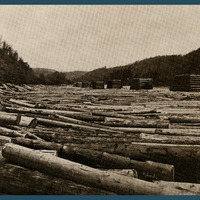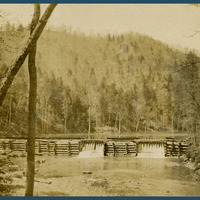-
Title
-
Log boom constructed by the St. Lawrence Boom and Manufacturing Company on the Greenbrier River, near Ronceverte, Greenbrier County, WV.
Splash dam on the Guyandotte River, Raleigh County, WV, 1907.
-
Caption
-
During the dry summer months, logging companies constructed splash dams on streams. These dams held back water until stream levels were high enough to float logs. When the dam gates opened, the rushing water carried logs downstream.
To help loggers direct and sort the floating timber, booms caught and held logs as they traveled downriver to sawmills. The booms consisted of two main parts: 1) “cribs” made from logs stacked in a square-shaped tower and anchored with huge rocks, and 2) “strings” of logs chained together to create a floating barrier and connect the cribs.
According to one local historian, most boom companies in West Virginia “went up the creek into bankruptcy” once railroads replaced waterways as the principal way of moving logs to the mills.


